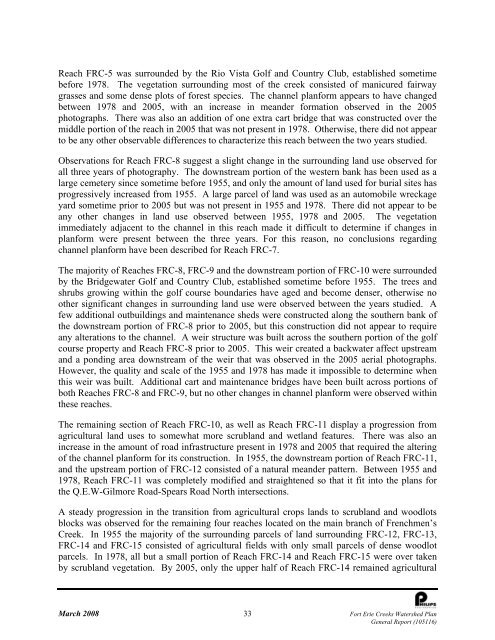Fort Erie Creeks Watershed Plan - Niagara Peninsula Conservation ...
Fort Erie Creeks Watershed Plan - Niagara Peninsula Conservation ...
Fort Erie Creeks Watershed Plan - Niagara Peninsula Conservation ...
You also want an ePaper? Increase the reach of your titles
YUMPU automatically turns print PDFs into web optimized ePapers that Google loves.
Reach FRC-5 was surrounded by the Rio Vista Golf and Country Club, established sometime<br />
before 1978. The vegetation surrounding most of the creek consisted of manicured fairway<br />
grasses and some dense plots of forest species. The channel planform appears to have changed<br />
between 1978 and 2005, with an increase in meander formation observed in the 2005<br />
photographs. There was also an addition of one extra cart bridge that was constructed over the<br />
middle portion of the reach in 2005 that was not present in 1978. Otherwise, there did not appear<br />
to be any other observable differences to characterize this reach between the two years studied.<br />
Observations for Reach FRC-8 suggest a slight change in the surrounding land use observed for<br />
all three years of photography. The downstream portion of the western bank has been used as a<br />
large cemetery since sometime before 1955, and only the amount of land used for burial sites has<br />
progressively increased from 1955. A large parcel of land was used as an automobile wreckage<br />
yard sometime prior to 2005 but was not present in 1955 and 1978. There did not appear to be<br />
any other changes in land use observed between 1955, 1978 and 2005. The vegetation<br />
immediately adjacent to the channel in this reach made it difficult to determine if changes in<br />
planform were present between the three years. For this reason, no conclusions regarding<br />
channel planform have been described for Reach FRC-7.<br />
The majority of Reaches FRC-8, FRC-9 and the downstream portion of FRC-10 were surrounded<br />
by the Bridgewater Golf and Country Club, established sometime before 1955. The trees and<br />
shrubs growing within the golf course boundaries have aged and become denser, otherwise no<br />
other significant changes in surrounding land use were observed between the years studied. A<br />
few additional outbuildings and maintenance sheds were constructed along the southern bank of<br />
the downstream portion of FRC-8 prior to 2005, but this construction did not appear to require<br />
any alterations to the channel. A weir structure was built across the southern portion of the golf<br />
course property and Reach FRC-8 prior to 2005. This weir created a backwater affect upstream<br />
and a ponding area downstream of the weir that was observed in the 2005 aerial photographs.<br />
However, the quality and scale of the 1955 and 1978 has made it impossible to determine when<br />
this weir was built. Additional cart and maintenance bridges have been built across portions of<br />
both Reaches FRC-8 and FRC-9, but no other changes in channel planform were observed within<br />
these reaches.<br />
The remaining section of Reach FRC-10, as well as Reach FRC-11 display a progression from<br />
agricultural land uses to somewhat more scrubland and wetland features. There was also an<br />
increase in the amount of road infrastructure present in 1978 and 2005 that required the altering<br />
of the channel planform for its construction. In 1955, the downstream portion of Reach FRC-11,<br />
and the upstream portion of FRC-12 consisted of a natural meander pattern. Between 1955 and<br />
1978, Reach FRC-11 was completely modified and straightened so that it fit into the plans for<br />
the Q.E.W-Gilmore Road-Spears Road North intersections.<br />
A steady progression in the transition from agricultural crops lands to scrubland and woodlots<br />
blocks was observed for the remaining four reaches located on the main branch of Frenchmen’s<br />
Creek. In 1955 the majority of the surrounding parcels of land surrounding FRC-12, FRC-13,<br />
FRC-14 and FRC-15 consisted of agricultural fields with only small parcels of dense woodlot<br />
parcels. In 1978, all but a small portion of Reach FRC-14 and Reach FRC-15 were over taken<br />
by scrubland vegetation. By 2005, only the upper half of Reach FRC-14 remained agricultural<br />
March 2008 33 <strong>Fort</strong> <strong>Erie</strong> <strong>Creeks</strong> <strong>Watershed</strong> <strong>Plan</strong><br />
General Report (105116)
















